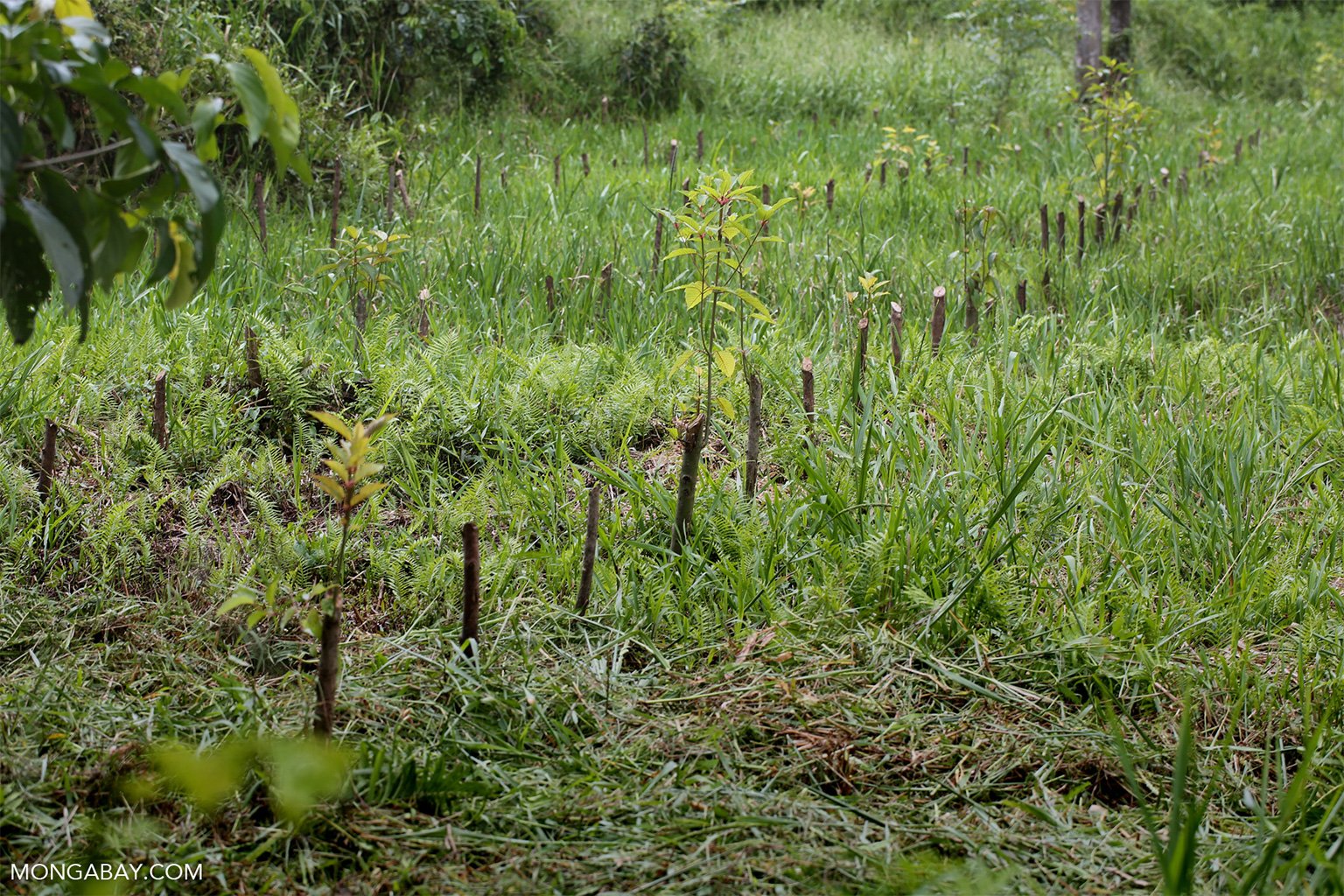- A recent survey of reforestation efforts in South and Southeast Asia found that about half of trees planted as part of such projects died within a decade.
- The study also identified factors that increase the chances of survival; for example, trees planted in sites with existing forest were more likely to survive than trees planted on open land.
- The researchers also noted that few projects carry out long-term monitoring after the initial planting, even though it takes decades for forests to regrow.
Planting trees may seem like a simple, unifying endeavor to restore ecosystems and meet climate goals. But once the saplings are in the ground and event photos posted online, forest restoration becomes a real challenge.
A recent study tracking forest restoration projects in South and Southeast Asia found that, on average, 44% of trees planted as part of such efforts died within five years, rising to almost half of the replanted forests at the 10-year mark.
However, while restored trees died at discouraging rates, especially as time progressed, the study indicates that making small changes in a restoration site can make a big difference for the forest’s future.
Impact factors
The study draws on data from published studies and the FOR-RESTOR network of tropical forest restoration site data from sites across South and Southeast Asia. It pulls tree survival rates in tropical and subtropical forests as well as details like size, variety and forest types into the mix to understand the variables that play into the success of forest restoration.
The study found that one of the biggest influences on a restored forest’s survival is the type of land used. Average mortality rates were 20% higher on open, degraded land than in forest sites.
The authors also noticed differences between restorations in mineral soil versus in peat swamps: in the first year after replanting, tree mortality is higher, at 28%, in peat swamps than in soil, at 14%. But beyond that point, tree deaths were lower in peat swamps.
Many of the factors that influenced tree mortality appear to be based on conditions that can be controlled, such as site selection. But, the researchers say, because monitoring tends to drop off after the initial planting, mortality rates get harder to track over longer time periods.
Lindsay Banin, a co-author on the restoration review and statistical ecologist at the UK Centre for Ecology & Hydrology, points to some reasons for why monitoring can drop off: some projects may age out of their funding cycles; some project managers may lose interest in collecting data after their report is published; and other projects may just have too high of a mortality rate to continue.
Because forests take decades to regrow, longer-term studies are needed, Banin says. “Enhancing the availability of [restoration] information would help to tackle important applied questions around how landscape context can influence restoration outcomes, and the circumstances under which trees must be planted versus conditions where natural regeneration would be sufficient, and whether there are important components of the flora, fauna and microbiota missing,” she says.
Study co-author Stuart Smith, of Nanyang Technical University’s Asian School of Environment in Singapore, who also led a recent review of forest restoration in peat swamps, notes that data for restoration efforts in peat swamps is particularly short-term.
For example, Smith says that in his previous study, his team was only able to review peat forest restoration efforts that were less than 2 years old, while restorations need decades to generate results.

Site selection
Reki Kardiman, author of a 2019 study that found that forest restoration efforts in the Malay Peninsula may thrive or die based the types of trees planted, agrees there’s a need for restoration sites to account for the species planted as well as site conditions. Even the socioeconomic aspects of a restoration site can have an impact, he says, adding that both scientific and local knowledge drive the survival rate of a forest restoration project.
“Restoration research should involve local knowledge in terms of species selection, what … could be good for their future livelihood,” he says. “At least it can guarantee the restored forest from second-round deforestation.”
Banin says she sees key gaps in her study and in previous literature — for instance, more work is needed to connect specific indicators like survival rate to the broader recovery of a forest ecosystem — but she sees this survey as a good starting point, especially for informing those putting trees into the ground.
“We hope to do more work translating our research to broader audiences,” she says. “Finding effective ways to share experiences and knowledge around things that have worked well or less so is also crucial, so that new projects don’t have to start the learning process from scratch.”
Banner image: Community members restore coastal mangrove forests near Davao city in the Philippines. Image DAI/USAID Biodiversity & Forest via Flickr (CC BY-NC 2.0).
Related reading:
Mongabay’s new-look Reforestation.app makes finding the right tree-planting project easier
Citations:
Banin, L. F., Raine, E. H., Rowland, L. M., Chazdon, R. L., Smith, S. W., Rahman, N. E. B., … Burslem, D. F. (2022). The road to recovery: a synthesis of outcomes from ecosystem restoration in tropical and sub-tropical Asian forests. Philosophical Transactions of the Royal Society B, 378(1867), 20210090. doi:10.1098/rstb.2021.0090
Smith, S. W., Rahman, N. E. B., Harrison, M. E., Shiodera, S., Giesen, W., Lampela, M., … Lee, J. S. (2022). Tree species that ‘live slow, die older’enhance tropical peat swamp restoration: evidence from a systematic review. Journal of Applied Ecology, 59(8), 1950-1966. doi:10.1111/1365-2664.14232
Kardiman, R., Afriandi, R., Schmidt, L. H., Ræbild, A., & Swinfield, T. (2019). Restoration of tropical rain forest success improved by selecting species for specific microhabitats. Forest Ecology and Management, 434, 235-243. doi:10.1016/j.foreco.2018.12.028











